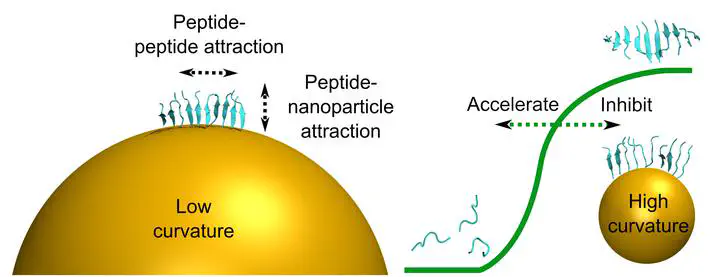Mechanistic insights into the size-dependent effects of nanoparticles on inhibiting and accelerating amyloid fibril formation
 Graphical Abstract: Elsevier
Graphical Abstract: ElsevierAbstract
The aggregation of peptides into amyloid fibrils has been linked to ageing-related diseases, such as Alzheimer’s and type 2 diabetes. Interfaces, particularly those with large nanostructured surfaces, can affect the kinetics of peptide aggregation, which ranges from complete inhibition to strong acceleration. While a number of physiochemical parameters determine interfacial effects, we focus here on the role of nanoparticle (NP) size and curvature. We used thioflavin T (ThT) fluorescence assays to demonstrate the size-dependent effects of NPs on amyloid fibril formation for the peptides Aβ40, NNFGAIL, GNNQQNY and VQIYVK. While 5 nm gold NPs (AuNP-5) retarded or inhibited the aggregation of all peptides except NNFGAIL, larger 20 nm gold NPs (AuNP-20) tended to accelerate or not influence peptide aggregation. Differences in the NP effects for the peptides resulted from the different peptide properties (size, tendency to aggregate) and associated surface binding affinities. Additional dynamic light scattering (DLS), electron microscopy, and atomic force microscopy (AFM) experiments with the Aβ40 peptide confirmed size-dependent NP effects on peptide aggregation, and also suggested a structural influence on the formed fibrils. NPs can serve as a surface for the adsorption of peptide monomers and enable nucleation to oligomers and fibril formation. However, molecular dynamics (MD) simulations showed that peptide oligomers were less stable at smaller NPs. High surface curvatures destabilized prefibrillar structures, which provides a possible explanation for inhibitory effects on fibril growth, provided that peptide-NP surface binding was relevant for fibril formation. These mechanistic insights can support the design of future nanostructured materials.